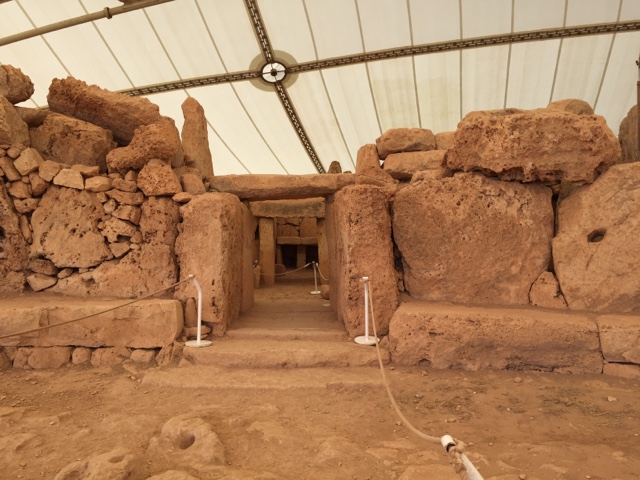Today the van picked us up bright and early (and on time! different driver) for a drive to Valletta to meet Dr. Anthony Bonanno, Professor of Classics and Archaeology at the National Museum of Archaeology in Valletta. We arrived early, but the coffee and pastry shops along Republic Street in Valletta helped us to pass the time until the Museum opened at 9 a.m.
 |
| Dr. Bonanno explains Neolithic artifacts |
Dr. Bonanno had lectured our class twice on campus, once on the earliest Neolithic prehistory of Malta, and again just yesterday on the Roman period. His tour of the museum began where his lectures had, with the earliest Neolithic settlers of the islands. He reminded us of the links to similar Neolithic evidence from Sicily, supporting the idea that the first settlers had come from there.
 |
| A number of "fat lady" statues, which were the focal points of all the temples. Heads were separate, and fit into a slot between the shoulders. No one knows why. |
We moved on to rooms that highlighted artifacts from the "Temple Culture" of the late Neolithic period. Many of the things here had been found at places we had visited just a couple days ago, Hagar Qim and Mnajdra. Other artifacts were from the Tarxien Temple and Hypogeum -- sites on tap for this afternoon.
 |
| The famous "Sleeping Lady" statue that was recovered from the Hypogeum. She was made of fired clay nearly 5000 years ago. |
Upstairs we entered the Bronze Age and the Phoenician Period. We learned that the Phoenicians -- while innovators in maritime navigation, trade, and the invention of the alphabet -- were generally only imitators when it came to art and religion. Phoenician pottery was very utilitarian, with the fancy pieces imitating the Greeks. Their religion was largely borrowed from Egypt.
 |
| Bronze Age olive or wine press. |
Malta entered the Roman Period in the Second Punic War in 218 BCE, and that is where this museum's exhibits end. An expansion into the Roman and Byzantine Periods has been in the planning stages for nearly a decade, but nothing has yet come of it. Dr. Bonanno took his leave, and after walking around just a bit more to appreciated the Baroque Era building in which the exhibits are housed, we took our lunch.
 |
| Phoenician burials mimicked the Egyptians. |
 |
| 18th century ballroom in the Museum building. |
The van then transported us to Tarxien to visit the Hypogeum. This is a Neolithic burial temple which may have started as a natural cave, but was expanded over a period of almost 2000 years to a labyrinth of chambers. All of it was carved into solid rock using other, harder rocks or in some cases, hardened animal bones and antlers which can be used as a sort of drill. Carving deep into rock using tools like these would require enormous patience, because the work would be exceedingly slow.
 |
| A museum model of Mnajdra shows the "cloverleaf" architecture common to the Megalithic temples of Malta, and not seen anywhere else in the world. |
Some portions of the underground complex were rough chambers where bones were piled (it's estimated that more than 7000 bodies were deposited here over a period of 10-15 centuries). Other areas were finely crafted to resemble the megalithic temples on the surface. Given what tools must have been available, the workmanship is astounding. Further, some red ocher paint of geometric designs remains visible in certain areas. These spaces were probably used for rituals of some sort, possibly related to funeral rites or something related to ancestor worship.
 |
| Downloaded image of one of the most famous chambers in the Hypogeum. |
Because the site is so fragile, with water and carbon dioxide from the exhaled breath of visitors constantly eroding the surfaces, only 10 visitors are allowed every hour. Also, even with these limitations the site is being damaged too rapidly, and it will close indefinitely next month. We were fortunate to be one of the last groups to visit. Unfortunately, no photos are allowed, so I've included one downloaded.
 |
| Tarxien Temple under protective canopy. |
Even so, only half of our group could enter at any one time. So while the other half was underground, some of the rest of us went about five minutes' walk to the Tarxien Temples. This is a site very similar to Hagar Qim and Mnajdra, which we saw on Thursday. It is a bit smaller, however, it is right in the urban area and it is somewhat better preserved. It's also interesting because the people who came later, in the late Neolithic, used the ruins as a cremation site.
 |
| Huge clay-fired pot at Tarxien (this is a faithful replica, the original is back at the Museum). |
 |
| One of the many altars at Tarxien (this is a faithful replica, the original is back at the Museum). |
Interestingly, the area is still used for burials, as a modern cemetery is right next door. We took a minute to walk through part of it, marveling that multiple burials still take place here, just as in ancient times. Bodies are laid in family tombs until another family member has need of the same space, then the bones are piled into a corner of the tomb and the next body moves in.
 |
| Modern Maltese cemetery. |
The more things change, the more they stay the same?
























































